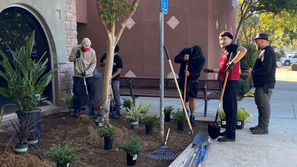Nevada Gov. kept thief out of jail
- Bill Coate
- May 25, 2022
- 4 min read

For The Madera Tribune
The Southern Hotel, shown in this 1905 photograph, was normally a quiet place. In 1903, however, the proprietor, J.M. Hambleton, became an unknowing participant in one of the wildest scams that was ever attempted in Madera. It’s a pity we don’t know the rest of the story.
Historians have to be careful about putting a period at the end of their stories. They almost never get all of the facts. A prime example of this can be found in a tale I wrote a few years ago. It was about the “suicide” of Jack Barnes.
This week, while researching something else, I ran across another wrinkle in the Barnes story.
The original story began in the Southern Hotel, which was located on Madera’s North B Street at the turn of the century. Most of the time it was business as usual at the hotel. Guests checked in and out; meals were served, and local gossip was exchanged in the parlor. In 1903, however, J.M. Hambleton, the proprietor, became an unknowing participant in one of the wildest scams that was ever attempted on this community.
It seems that a certain man known as Jack Barnes at one time made the Southern Hotel his home, but had recently disappeared after breaking into a local courtesan’s room and stealing her clothing. The wanted notices went out, but little hope was held for capturing the thief. Then in July of 1903, Hambleton received correspondence from Elko, Nevada.
J.J. Leary, who owned a hotel in Elko, wrote the letter. Leary informed Hambleton that one of his roomers, Jack Barnes, had committed suicide in the Nevada hotel. According to the letter, Barnes shot himself through the heart.
Leary told of Barnes’ arrival in Elko on the ninth of July and of a valise which followed via the Wells Fargo stage from Sacramento. Leary wrote after Barnes’ death that the valise was searched and its contents were revealed. The effects of the deceased included a discharge from the army dated June 30, 1901, a card bearing Hambleton’s name, and the address of the Southern Hotel. In addition, Leary related that Barnes had died with $75 dollars in gold and $4.35 in silver on his person.
Hambleton was urged by Leary to take the news to the Madera newspaper so that the community could be informed. The Nevada hotel operator was apparently unaware that Barnes was a wanted man. Hambleton did as he was requested, and the Madera Mercury carried the headline, “Jack Barnes Suicides.” Many Maderans were genuinely saddened at the tragic turn of events, for after his tour of duty in the Philippines with the U.S. Army, Barnes had come to Madera and made a good many friends.
Shortly after his arrival here, Barnes established the reputation of being a “hardworking young man.” He apparently was quite likable, but then things began to sour for him. He lost his good name when he began to seek out “the society of soiled doves,” and on July 4, Barnes was accused of breaking into Jeanette Boswell’s room and stealing her clothes. A warrant was issued for his arrest immediately.
After Hambleton took the announcement of Barnes’ suicide to the newspaper, “many of Jack’s friends here read the account of how the former Maderan, worried over his fugitive status, had done away with himself.” The authorities were about ready to close the case against the clothes-snatcher when Under-Sheriff Hensley became suspicious.
Hensley suspected that the letter from Nevada was a forgery — that Barnes had written it himself so that the law would take him off the wanted list. At about the same time that Hensley was voicing his suspicions to Sheriff Jones, Mr. Hambleton was taking another look at Leary’s letter. There was something strangely familiar about the looks of it. The hotel operator went to his register and “turned to the page where Barnes had placed his signature.” All doubts were removed. The handwriting on the letter matched perfectly with the signature in the register. J.J. Leary was Jack Barnes!
When apprised of Hambleton’s discovery, Hensley and Jones wrote to the Elko authorities to inquire about Barnes’ suicide. The answer came back that no one in that town had committed suicide. The news confirmed the Madera lawmen in their suspicions, and “they immediately sent out cards containing a description of the wanted man.”
On July 28, 1903, the authorities in Madera received word from the constable in Elko that he had located Barnes working on a hay ranch just outside of town and could easily apprehend the lawbreaker. Sheriff Jones wired back that Madera County would stand the expense of capturing Barnes and bringing him back to Madera. Within a week Barnes was caught and “safely stowed away in jail.”
All of the story above is true, but the problem is that it is not the whole truth. We have more to tell, but it still leaves us looking for the end.
When Sheriff Jones and Under-sheriff Hensley went to Elko, They found that Barnes was as free as a bird. The Governor of Nevada had refused to sign the extradition order allowing the Madera lawmen to take Barnes back home.
So, Barnes remained in Elko, working on a farm, while Jones and Hensley returned to Madera, and as far as we know, that’s where the scam artist remained.
Now, we are going to resist the temptation to call this the end of the story. We still don’t know why the Governor refused to order Barnes’ extradition, so stay tuned; we never know what is going to turn up next.


























Comments